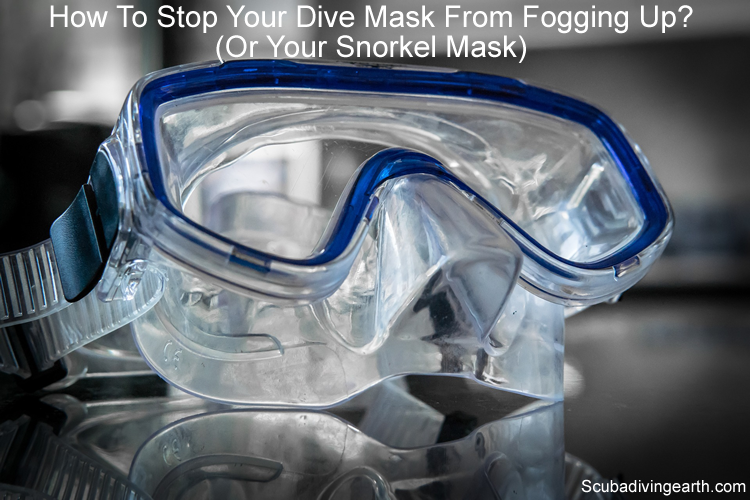
8 ways to prevent a scuba or snorkel mask from fogging
There’s nothing worse than when you’re diving (or snorkeling) to have a mask fog up. If it does, you won’t be able to see what’s going on. Mask fogging is more of an irritation than a serious risk or danger. Even if fogging does happen to you during a dive see tip No. 7 below on how to deal with this.
“I always take a small bottle of baby shampoo with me on every dive trip to smear the inside of my mask to prevent it from fogging up, but if I forget to take the baby shampoo, or if I’m out snorkeling, I use my own saliva on the inside of the mask which works just as well. If my mask fogs underwater, I let in a small amount of water to clear the mask of fog.”
The best way to do more diving is to book yourself on a scuba diving liveaboard. You can check the latest and best deals on liveaboards using the following window (opens in a new window):

Or search our dive liveaboard pages here:
8 top tips to stop your dive mask from fogging up:
- Baby shampoo on the inside of your mask.
- Spit or saliva on the inside of your mask’s lens.
- Commercial defogging agents sprayed on your mask lens.
- Defog with toothpaste.
- A small amount of washing up liquid.
- Glycerine soaps work.
- Mask clearing on the dive.
- The juice of a potato.
I’m sure dive mask fog has happened to all divers and snorkelers at some point.
But it’s something that beginner divers and those getting certified should know how to prevent. When you’re snorkeling or scuba diving you want to be able to see everything.
Before going into a bit more detail on these 8 ways of how to stop your dive mask from fogging up, let’s take a look at why it fogs up in the first place.
Why does my mask fog up – the science bit?
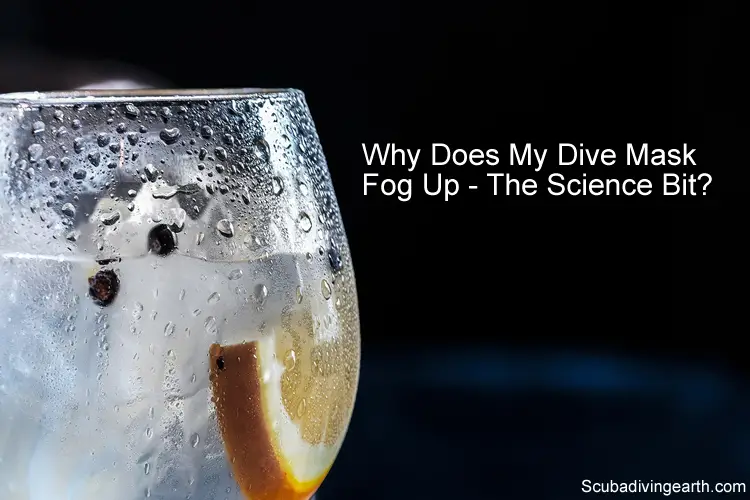
Air contains a certain amount of water in the form of tiny water droplets, which is described as humidity. Fogging occurs when the tiny water droplets condense onto a surface, which is caused by the surface being colder than the temperature of the air.
This happens in our homes if we don’t have double glazing. It happens when the outside temperature falls below what the temperature is on the inside of the house. Another example of water condensing is on the outside of a glass when ice is added to the drink, as per the image above.
Let’s now take a look at how to stop your dive mask from fogging up in more detail.
How to stop your dive mask from fogging up
1. A few drops of baby shampoo on the inside of your mask
The first and my favourite solution to mask fog is baby shampoo. Baby shampoo can be used just like commercial defogging solution.
All that’s required is to rub a few drops of the baby shampoo onto the inside of the lens of the mask. Always rinse the mask out to remove excess shampoo though.
However, one of the main benefits of using baby shampoo is that most are hypoallergenic. This means they are gentle on the skin and eyes. Baby shampoo is made to be used with babies. And babies don’t always understand about closing their eyes when they’re having their hair washed.
So although, I wouldn’t recommend getting the concentrated baby shampoo into your eyes, it shouldn’t affect your eyes too badly if you do. However, if there is a small amount of residue left after rinsing you mask, this could still irritate your eyes. So always be careful to rinse with water, before placing your dive mask on your face.
The bonus about baby shampoo is it smells nice. Plus most are also biodegradable.
2. Old fashioned spit or saliva on the inside of your mask’s lens
The old fashioned way to defog a mask was to spit on the inside of the lens (I still sometimes use this trick). This works in the same way as the baby shampoo example.
This works in the same way. Which means you spit (sorry if this sounds gross) on the inside of the mask and smear your saliva around the whole of the glass.
Rinse the mask off in water before you put it on your face. But don’t over rinse-off the saliva, otherwise your mask will still fog up.
Using your spit as an anti-fog agent needs to be done immediately before getting into the water. Don’t let your mask dry out.
This is a good fail safe method for keeping your mask clear of fog when there’s no other alternative.
Beginner nerves may give you a dry mouth
However, newbie divers are sometime nervous just before a scuba dive. When we are nervous, our saliva drys up. It’s a bit like the scenario of going out on stage. When stage fright hits, the mouth drys up.
It makes it harder to create saliva or spit when you are nervous. There’s no need to be afraid of diving, although it’s only natural to be nervous of any new activity.
To overcome this problem is to move your tongue around in your mouth, as if your swilling a drink around inside. Also, if you’re diving on a boat, have a cup of water and this will help.
3. Commercial defogging agents sprayed on your mask lens
You can buy commercial defogging agents that are specifically designed to prevent your mask from fogging up.
As with the previous methods, put a few drops of the defogging agent on the inside of the lens and then rinse the excess off in water.
Don’t rinse this too thoroughly, as you’ll remove all of the defogging agent off from your mask. This should leave a thin film of the defogging agent on the inside of your dive mask lens, which will prevent the mask from fogging up.
4. Defog with Toothpaste
Toothpaste is a solution to use on a new mask. When you first take your new diving mask from its packaging, the inside of the lenses may still be covered in a residue from the factory. It’s a good idea to rub an amount of toothpaste on to the inside of the mask glass and then rinse this off with water afterwards.
If you’re not immediately going to dive, you may wish to leave the toothpaste on for a few hours. This will help the tooth paste work on the residues left behind after it left the factory.
Make sure the toothpaste you’re using isn’t the abrasive type. The more basic the toothpaste, the better. The last thing you want to do is to damage or scratch the inside of the lens of your new scuba mask!
You can also use toothpaste as an anti fogging agent when you’re diving or snorkeling too. However, be careful when using toothpaste, as the mintiness of the toothpaste may irritate your eyes and cause a burning sensation.
I’d also recommend you don’t get toothpaste in your eyes. I’ve never had this happen myself, but I can imagine it being quite painful. So whilst, I recommend this option for cleaning a new dive or snorkel mask, I wouldn’t recommend it as a defogging solution when you are scuba diving or snorkeling.
For me, I’d rather use the saliva spit trick personally.
5. A small amount of washing up liquid
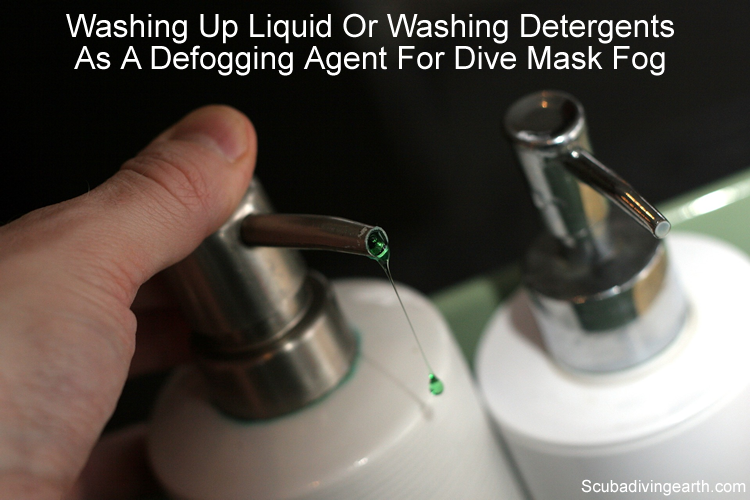
Washing up liquid works in the same way as the baby shampoo trick. However, shampoo is rarely hypoallergenic and they’re not always biodegradable either.
As with the other methods, put a few drops of the washing up liquid or detergent onto the inside of the mask lens. Rinse the residue off with water before putting the mask on.
Also, and unlike baby shampoo, if you get washing up liquid into your eyes, this hurts. It could completely spoil your dive if you get washing up liquid into your eyes.
Be very careful, because before now I have done this myself. I’d rinsed the mask on the surface only to find on the dive some of the residue washing up liquid found its way into my eyes. Let me tell you that this hurts.
This is more likely to happen if you’re using a backward roll off the dive boat. When you roll backwards off the boat any soap residue in your mask find its way into your eyes.
Quite often you don’t notice it right away. What normally happens is you only notice what’s happened when you get to the bottom, by which time it’s too late to do anything about it.
Apart from re-surfacing and aborting the dive. But unless the stinging in my eyes was really bad, I would never abort a dive for having soap in my eyes!
But what does happen, is you’ll then spend the rest of the dive profusely blinking your eyes, trying to get rid of the washing up liquid that’s in them. This becomes a bit of a distraction, and it will spoil the fun of the dive.
6. Glycerin soaps for mask fog agent
There are many other soaps to choose from to use as an anti-fogging agent. Glycerin soaps are one such de-fogging solution.
However, like washing up liquid or detergents, you don’t want to get this in your eyes. Use only a little of the soap on the inside of the mask lens again, but rinse it off before you put your mask on your face to dive or snorkel.
7. Clearing your mask whilst on the dive
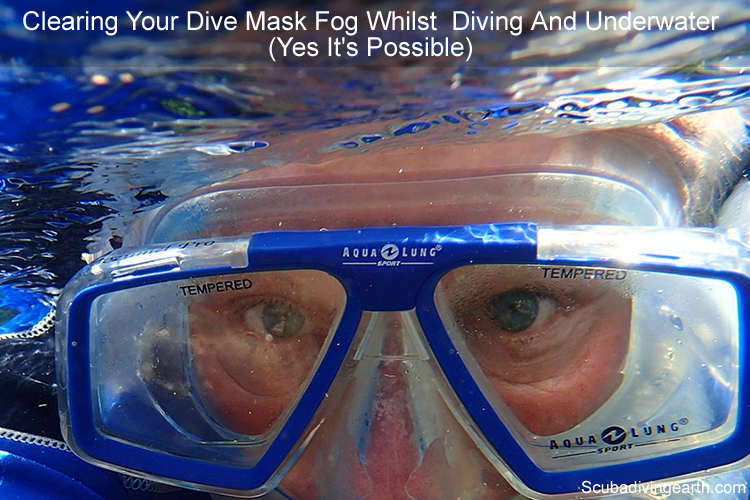
I have on occasion forgotten to put anti-fog agent on my mask. It’s usually when to get to the bottom when your mask fogs up.
Your mask can still fog even when defogging has been done. This is more often the case when using spit or saliva trick. This generally happens if the mask had dried out or the spit was completely rinsed off.
This is a bit irritating and it does make it more difficult to see things.
The solution to a fogged mask whilst on the dive
Tilt your head back and lift the bottom of your mask away from your face very slightly, as if you were about to take the mask off. Then let in a small amount of water into your mask.
Tilt your head forward again and swill the water across the lenses of your mask.
Be careful not to get any of the water in your eyes, especially if its sea water, as this tends to irritate your eyes due to the salt content. If its lake water, try not to get this in your eyes either, as lake water can include bacteria and cause an eye infection.
Once you’ve rinsed the inside of your mask, perform the mask-clearing exercise you were taught in your scuba diving training.
More Reading: How To Clear A Scuba Diving Mask (4 Simple Steps To Clear A Mask)
You’ll find that you will normally have to repeat this exercise a few times during the course of the dive, in order to keep your mask clear of fog.
This will be a lesson learnt and make you pay a bit more attention the next time you are anti-fogging your mask!
8. Use the juice of a potato
The other tip that I’ve not used myself is to use a potato. You are supposed to cut the potato in half and wipe the inside of the potato across the inside of the mask lens.
However, it’s unlikely to see anyone getting their potatoes out on a dive boat. I’m sure if they did, this would be extremely amusing and fun would be made.
If you hadn’t realised it so far, divers tend to have a great sense of humour (well most do, there’s always exceptions to any rule). Most British divers have sarcasm and whit. So be warned, if you get your potatoes out on a dive boat with a Brit on board, you may find you’re being laughed at!
Although, I’ve found this whit and humour to exist in most nationalities of diver. So be warned when using potatoes on a dive boat!
How do you clean a diving mask
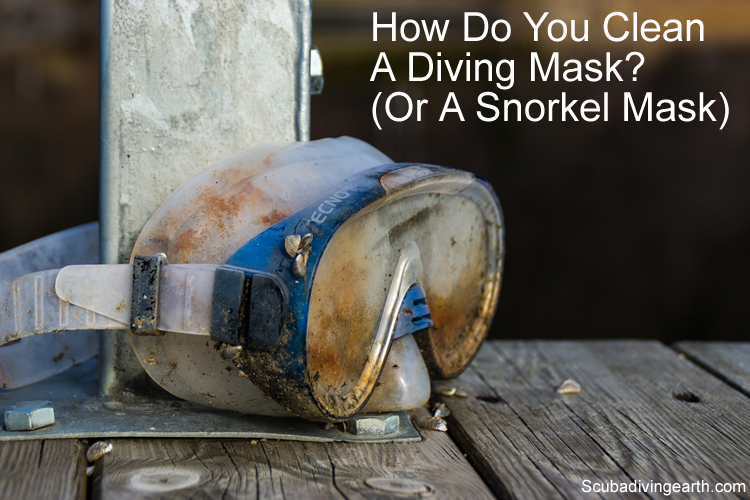
This may surprise you, but the main reason why a dive mask fogs up, is because it’s dirty. The dirt gives the condensed water droplets something to attach to. So one of the best ways to prevent dive mask fog, in addition to the tips below for how to stop a dive mask from fogging up, is to keep your mask clean.
The main reason for mask fogging is a dirty mask. Clean the inside of the lenses and you minimise the risk of your mask fogging up, when you scuba dive or when you snorkel.
To clean your mask you can use most of the solutions discussed below for dive mask fog. But in particular I’d recommend you use the baby shampoo, spit or washing up liquid and detergent on older dive masks.
How do you clean a new dive mask for the first time?
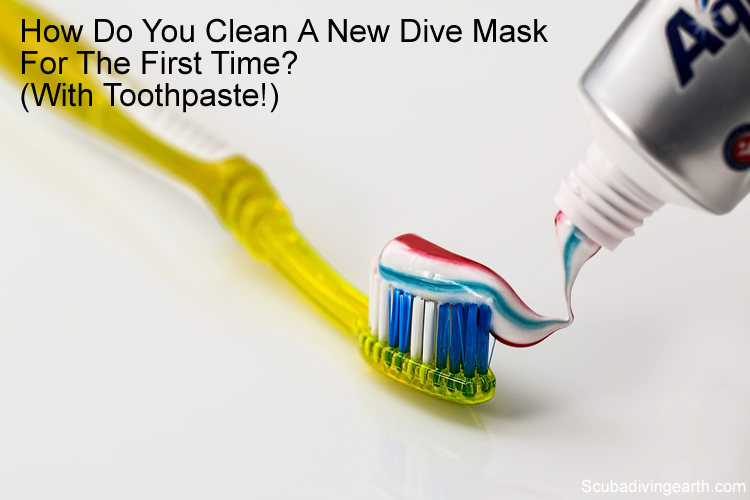
However, to clean a new mask for the first time, the best trick to remove the residue that’s on the mask from leaving the factory is to use toothpaste.
The best way to clean a new dive mask is to use toothpaste. For best results leave the toothpaste on the dive mask lens for a few hours. But be careful if your lens has an anti-reflective coating, if it does don’t use toothpaste.
If you’re not about to dive with the mask right away, it’s better to leave the toothpaste on for a few hours to work its magic on the film, which is normally on the inside of a new dive mask.
The other trick is to use a flame of a cigarette lighter. People suggest to run the flame over the inside of the glass of the mask to clean the residue off. However, this is a technique I’m not going to endorse.
The glass of dive masks is tempered glass, so this exercise is unlikely to damage the glass. However, the mask surround is made of silicone.
Silicone is not as equally fire resistant as glass is, and will melt if heated. The last thing you want to do, with your brand new dive mask out of the box, is to melt it with fire. So don’t do this. Toothpaste works just fine.
So now the concept of fogging is better understood, and you know how to clean your dive mask too, let’s take a look at the easy ways to prevent mask fogging.
Mask lens with anti-reflective coating
Don’t use anything abrasive on your mask lenses if you’ve chose one with an anti-reflective coating. Some mask lenses are finished with an anti-reflective coating which improves the light transmittance into the mask. This coating makes everything seem brighter.
Is there a difference between a scuba diving mask and a snorkel mask?
There are a number of differences between a scuba diving mask and a ‘snorkel mask.’ When I say ‘snorkel mask’ I don’t mean a regular mask and snorkel. For this I mean the type of mask that covers your entire face.
One of the main differences between these two types of masks is ‘snorkel masks‘ have the snorkel built-in to the mask. Which would make it dangerous to scuba dive using it.
The other main drawback of a snorkel mask is it cannot be used for surface dives (skin dives) when snorkeling.
A snorkel mask covers your entire face. This means you can breathe through your nose and mouth.
Whereas on a regular mask used for snorkeling and scuba diving covers your only nose. Which prevents you from breathing through it. With a regular mask, you have to breathe through your mouth.
This difference is another reason why the snorkel mask couldn’t be used for diving either. To dive underwater, you need to be able to equalise your ears. As you can’t get to your nose on a snorkel mask, you cannot perform the Valsalva maneuver to clear your ears. Plus you wouldn’t be able to put your regulator in your mouth.
So you won’t be able to surface dive (skin dive) or scuba dive with a snorkel mask.
The other difference between these types of mask is important to understand with regards to the anti-fogging techniques described in this article.
The lenses on a snorkel mask are made of plastic. Whereas on a regular mask they are made of tempered glass for safety.
For snorkel masks apply the same techniques to prevent them fogging up
So if you have snorkel mask that is fogging up, you can apply all of the same techniques and tips above. This is with the exception of using the toothpaste trick. A plastic lens is more likely to become scratched, so be careful.
A scratched lens will lessen your snorkel experience through reduced visibility.
The principles for dive mask fog are the same for a snorkel mask, as they are for a regular mask.
How do you keep a snorkel mask from fogging up?
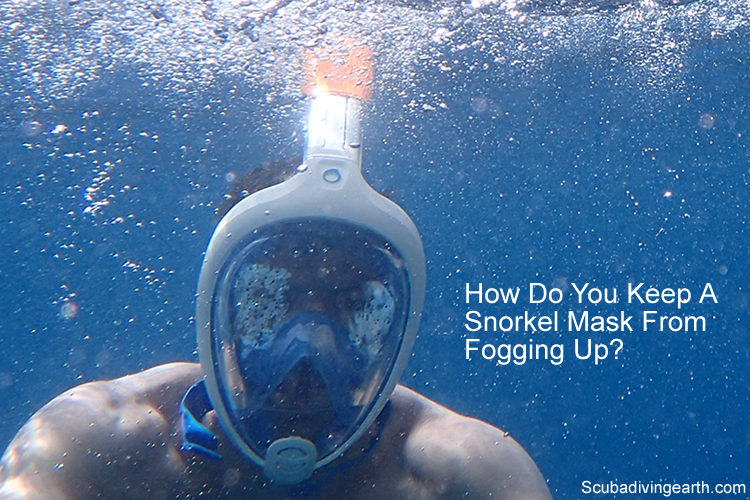
If you have a snorkel mask and you’re using it in colder waters, and when I say colder I mean below around 18 degrees centigrade (64.4 Fahrenheit). Due to the science behind why masks fog up, your snorkel mask will likely to fog.
This fogging for a snorkel mask is despite the anti-fog system. The anti-fog system claims to work in temperatures above the 18 degrees.
If your snorkel mask does fog up, simply apply the same principle in this guide. As you would with a regular mask.
This is with the exception of using toothpaste on the lenses. The lenses of a snorkel mask are not made of tempered glass like a regular lens. But instead they’re made of plastic.
A plastic lens is more prone to scratching. So be that little bit more careful when you’re touching them to avoid this happening.
My recommendation for dive mask fog and how to stop your dive mask from fogging up
My top tip for keeping your mask clear of fog is to use baby shampoo. It works, it’s eye friendly, being hypoallergenic, and it smells nice. Plus its not bad for the environment too. Baby shampoo is readily available in most chemists or super markets and is cheap to buy.
What I’ve always found is that most, if not all dive boats will carry some form of de-fogging liquid. Be it baby shampoo, washing up liquid or whatever they prefer as a method to prevent fogging. Also, you’ll find that even if the dive boat doesn’t have some anti-fogging agent, one of the other divers is bound to have some.
If all else fails, where the dive boat doesn’t have an anti-fogging agent, none of the other divers do, and you’ve forgotten your own. Then good old fashioned spit will work.
However, Except for using spit, always be careful to not leave too much residue of the anti-fogging agent in your mask. If you do, this could cause irritation and this may affect the enjoyment of your dive.
I hope you enjoyed this article about how to stop your dive mask from fogging up
I’d love to hear from you. Tell us about your adventures of diving and snorkeling, in the comments below. Please also share your photos. Either from your underwater cameras or videos from your waterproof gopro’s!
If this article hasn’t answered all of your questions. If you have more questions either about snorkeling or scuba diving (or specifically about dive mask fog and how to stop your dive mask from fogging up, or snorkel masks), please comment below with your questions.
There will also be many more articles about scuba diving (and on snorkeling). So please bookmark our site to pop back to read and learn more about this fabulous sport.
Have fun and be safe!
#ScubaFoggingTips

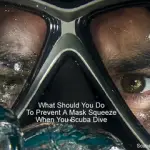
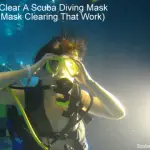
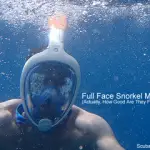

Hello,
Q: Using a diver mask and snorkel and fogging
happens, tipping your head up and letting
some water in, tilting head down and shaking
your head to swish the water in the mask…
How do you get that water out of your
mask?
Hi Robert, The best way to get the water out of your mask when you’re underwater is to put one or two fingers on the top of the mask and push gently against the top of the mask, then as you tilt your head back breath out through your nose. This will push the water out through the bottom of the mask, and by using your fingers at the top of the mask, this will stop the top of the mask coming away from your face.